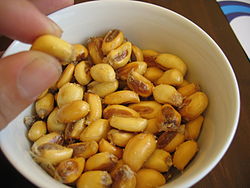The examples and perspective in this article may not represent a worldwide view of the subject.(July 2022) |
 Cancha in Peru | |
| Course | Snack |
|---|---|
| Place of origin | Peru |
| Region or state | South America |
| Associated cuisine | Peru, Ecuador |
| Ingredients generally used | Roasted or deep-fried corn kernels |

Corn nuts, [1] also known as toasted corn, [2] are a snack food made of roasted or deep-fried corn kernels. It is referred to as cancha in Peru, chulpi in Ecuador, kikones in Spain, and cornick in the Philippines.
